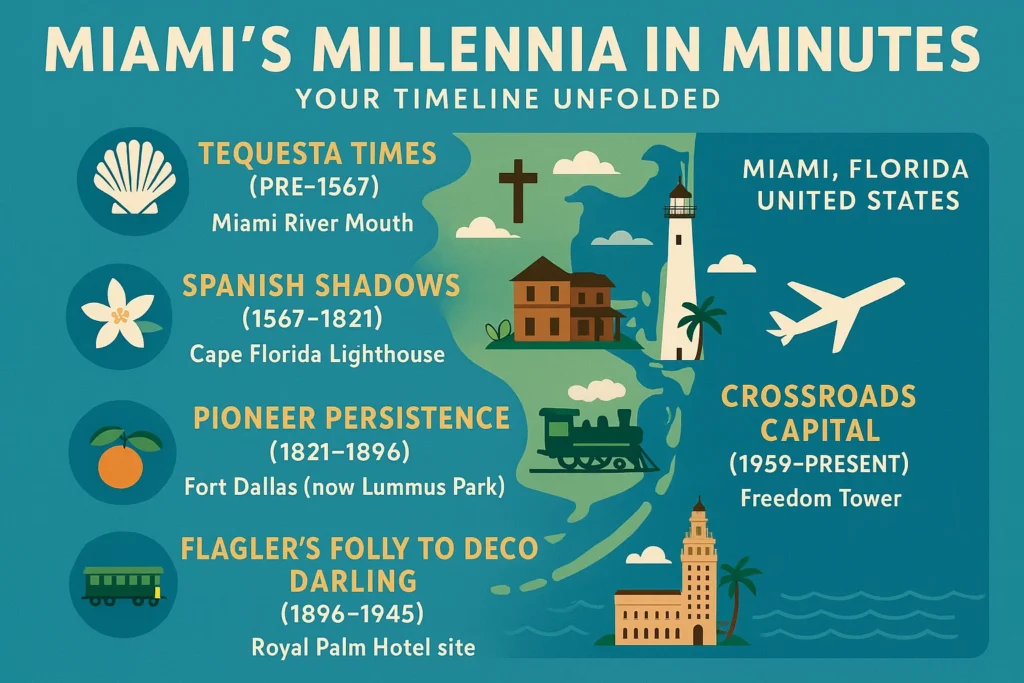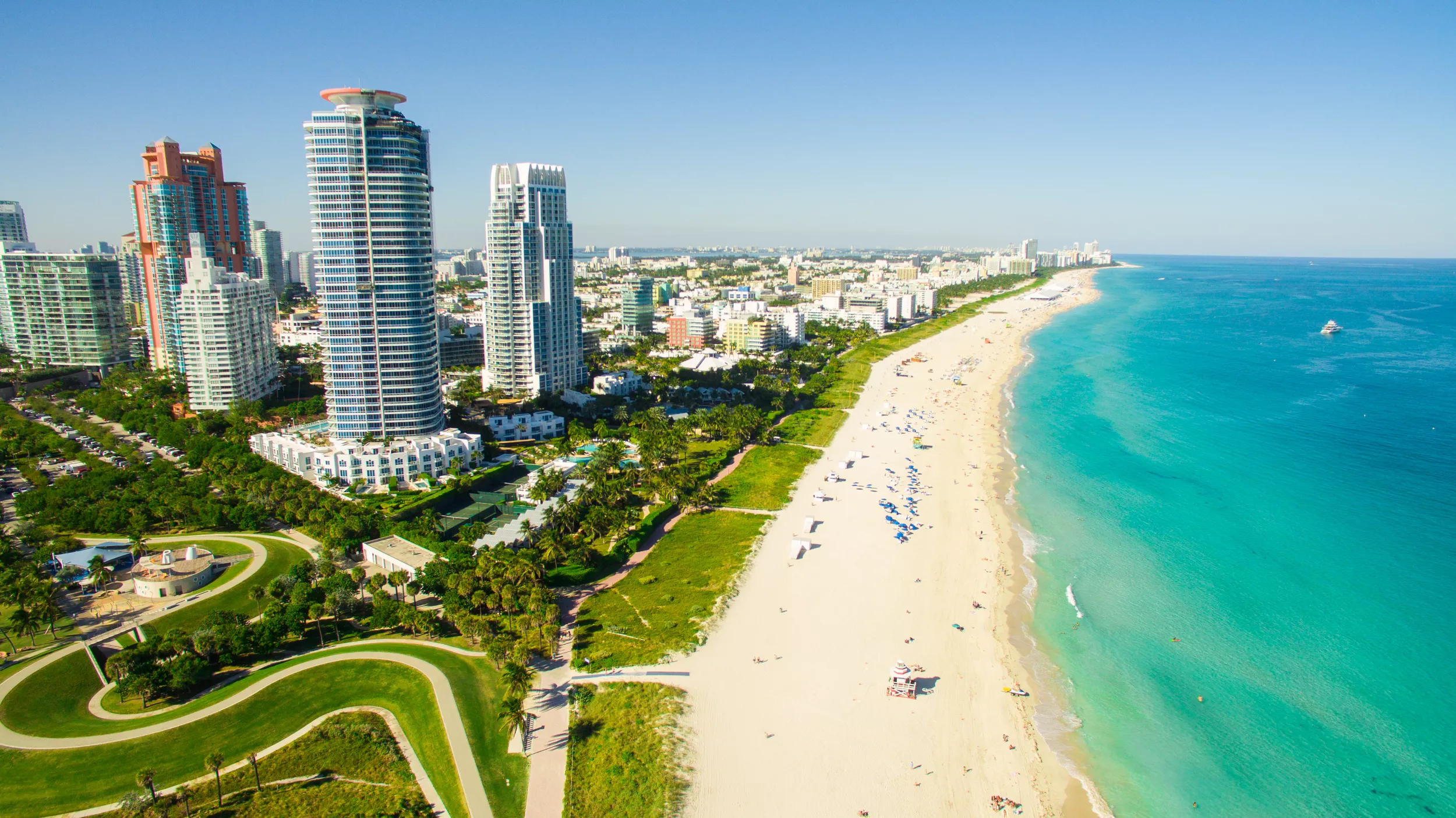Forget the postcards for a second. What if Miami’s beaches could talk?
Feel that? Warm sand squishing between your toes right here on South Beach. But that turquoise water and thumping club music? That’s just the shiny top layer. Dig a little deeper – way deeper. Imagine the rhythmic thwack of a Tequesta Indian’s paddle right here, maybe 2,000 years ago. Fast forward: catch the sweet, citrusy crackle of Julia Tuttle’s orange blossoms – that smell practically built the railroad. Then sneak into the shadows of a Coconut Grove speakeasy, where rumrunners whispered plans over smuggled whiskey.
Miami isn’t just sun and sandcastles. It’s a wild cocktail mixed from crazy dreams, spectacular crashes, and cultures smashing together. Ready to hear the real stories this sand is sitting on?
Miami Florida Verenigde Staten: Unmasking the Magic City’s Past
Why History Doesn’t Just Whisper Here—It Sizzles
Forget dusty museums behind glass (though we have great ones!). Miami Florida Verenigde Staten wears its history like Art Deco chrome—bold, vibrant, and embedded in everyday life. Think of it like peeling an onion (or better yet, slicing open a Key Lime pie). Each layer reveals a different flavor:
- The Ancient Core (Pre-1500s): Long before skyscrapers, the Tequesta thrived. Their legacy? Not grand temples, but shell mounds – ancient landfills turned sacred sites.
Feel, standing on the Miami Circle (downtown Brickell), a mysterious 2,000-year-old Tequesta structure carved into the limestone. Run your fingers over the ancient basin holes – it’s the city’s oldest fingerprint. - Pioneer Grit & Railroad Dreams (Late 1800s – 1926): Enter Julia Tuttle, the “Mother of Miami.” She didn’t just persuade railroad tycoon Henry Flagler to extend his line; she sent him orange blossoms after a freeze proved Miami’s resilience.
See, wandering Lummus Park downtown, home to Miami’s oldest surviving house (the William Wagner Homestead, 1855). It’s a humble pioneer cabin amidst gleaming towers – a stark reminder of the swampy frontier. - Boom, Bust & Deco Dreams (1920s – 1940s): The 1920s land boom was pure Miami madness – speculative frenzy fueled by brochures promising paradise. Then came the 1926 hurricane and the Great Depression. But from the rubble rose Art Deco, an architectural phoenix.
Experience, strolling Ocean Drive. Those pastel facades with “eyebrows” and neon weren’t just style; they were affordable, quick-to-build optimism after disaster. Look for the Colony Hotel – its original 1935 neon sign still glows. - Crossroads of the Americas (1959 – Present): The Cuban Revolution sparked an exodus that reshaped Miami forever. Little Havana isn’t just a tourist spot; it’s a living archive of exile, resilience, and cultural fusion.
Hear, the rapid-fire Spanish dominoes slamming onto tables at Domino Park (Maximo Gomez Park). The clatter isn’t just a game; it’s the soundtrack of community forged in displacement.

Mapping Your Time-Travel Expedition: Must-See Zones
Don’t just visit sites; step into eras. Here’s your temporal GPS:
| Zone | Time Period | Must-See Experience | Time Traveler Tip |
|---|---|---|---|
| Downtown/Brickell | Ancient & Pioneer | Miami Circle, HistoryMiami Museum, Wagner Homestead | Visit the Miami Circle at sunrise for quiet contemplation. |
| South Beach | Deco Golden Age | Art Deco Historic District, Ocean Drive, Española Way | Take a guided Art Deco walking tour (focus on why the style thrived here). |
| Coconut Grove | Pioneer & Bohemian | Barnacle Historic State Park, Vizcaya Gardens | Have coffee at a Grove cafe – this was Miami’s original artsy, counterculture hub. |
| Little Havana | Modern Transformation | Calle Ocho Walk of Fame, Domino Park, Tower Theater | Go early (8-10 AM) to see the neighborhood truly wake up. Grab a cafecito. |
Beyond the Postcards: Hidden Narratives & Local Lore
- The Secret Speakeasy Trail (Coconut Grove): During Prohibition, the Grove was awash with rum runners. Ask a local historian about hidden docks and the still-rumored tunnels beneath old bars like Taurus. Feel the intrigue.
- Graffiti as Modern Hieroglyphs (Wynwood Walls): Before it was an art mecca, Wynwood was an industrial wasteland. The murals aren’t just pretty; they’re a vibrant, evolving dialogue about immigration, gentrification, and identity – Miami’s modern history painted large. Decode the walls.
- The Ghosts of the Biltmore Hotel (Coral Gables): This 1926 luxury icon housed a WWII hospital, a university campus, and (allegedly) gangster meetings. Take their history tour – the pool area alone (once the world’s largest) whispers Jazz Age decadence and wartime urgency. Listen for the echoes.
Local Secrets: Eat, Sleep & Wander Like a History Detective
- Fuel Up Like a Pioneer: Skip the chains. Grab a hearty Cuban breakfast at Enriqueta’s Sandwich Shop (Calle Ocho, no frills, authentic). For a taste of old Miami seafood, Garcia’s Seafood Grille & Fish Market (downtown by the river) feels like stepping back 50 years.
- Sleep in a Storybook: The Plymouth Hotel (South Beach): A beautifully restored Art Deco gem off the chaotic Ocean Drive strip. The Biltmore Hotel (Coral Gables): Sleep where presidents and mobsters did. Pure 1920s grandeur.
- Off-the-Clock Exploration: Coral Gables Venetian Pool: A 1924 public pool carved from coral rock, fed by spring water – a whimsical relic of the City Beautiful movement. Ancient Spanish Monastery (North Miami Beach): A 12th-century cloister shipped stone-by-stone from Spain in the 1920s. Yes, really. Surreal and serene.
FAQs: Your Miami History Queries Answered
Q: What’s the most overlooked historical spot?
A: The Barnacle Historic State Park (Coconut Grove). Miami’s oldest home (1891) in its original location. It’s a tranquil time capsule of pioneer life under the hammock canopy. Ralph Munroe’s boathouse reveals Miami’s early maritime soul.
Q: Is Miami just beaches and nightlife? Can history handle kids?
A: Absolutely! Turn history into adventure: At HistoryMiami Museum, kids “dig” for replicas at the Tequesta site. Vizcaya becomes a treasure hunt for gargoyles and secret gardens. South Beach Art Deco? Hunt for quirky nautical motifs!
Q: Best time to visit for history buffs?
A: Late April-May or October-November. Avoid summer heat/humidity and peak winter crowds. You’ll explore more comfortably. Bonus: Shoulder seasons often have smaller tour groups.
Q: Is Little Havana just about Cuba?
A: It’s the epicenter of the Cuban exile story, but also reflects broader Latin American and Caribbean influences. Its history is intensely modern, shaped by ongoing waves of migration. The Tower Theater premiered Spanish-language films for exiles.
Q: Mythbuster: Was Miami really founded by a woman?
A: Essentially, yes! Julia Tuttle’s persuasive case (and those frost-free oranges) directly convinced Henry Flagler to extend his railroad, officially incorporating Miami in 1896. She’s the only woman to found a major US city.
Your Time-Traveler Toolkit: 3 Actions Before Landing
- Download the “New World Symphony” App: Not just for concerts. Their free Soundscape app features audio tours exploring the architectural and social history of South Beach’s Art Deco District. Put in headphones and stroll.
- Learn the Magic Words: At Versailles (Cafeteria) in Little Havana, whisper “¿Tienen croquetas preparadas?” (“Do you have croquetas ready?”). If they nod, you’ve scored the freshest, crispiest batch – a local insider move.
- Seek the Guardian: Find the majestic stone “El Espiritu del Éxodo” (Spirit of the Exodus) eagle sculpture at the Bay of Pigs Monument (SW 13th Ave & SW 8th St, Little Havana). Touch its base – it’s a powerful tribute to courage and sacrifice. Feel the weight of history.
Final Thought
Miami Florida Verenigde Staten isn’t a relic; it’s a palimpsest. The Tequesta shell mound lies beneath a downtown high-rise. A Deco hotel hosts a cutting-edge cocktail bar. Spoken Spanish mixes with Haitian Kreyòl and English. History here isn’t behind velvet ropes; it’s the rhythm of the salsa beat, the scent of cafecito, the glint of chrome against a setting sun over the Everglades. So, lace up your walking shoes, open your eyes wide, and listen beyond the waves. The Magic City’s past is waiting to share its secrets. What story will you uncover? Share your discoveries below.
You May Also Like: Fort Lauderdale Florida Verenigde Staten

